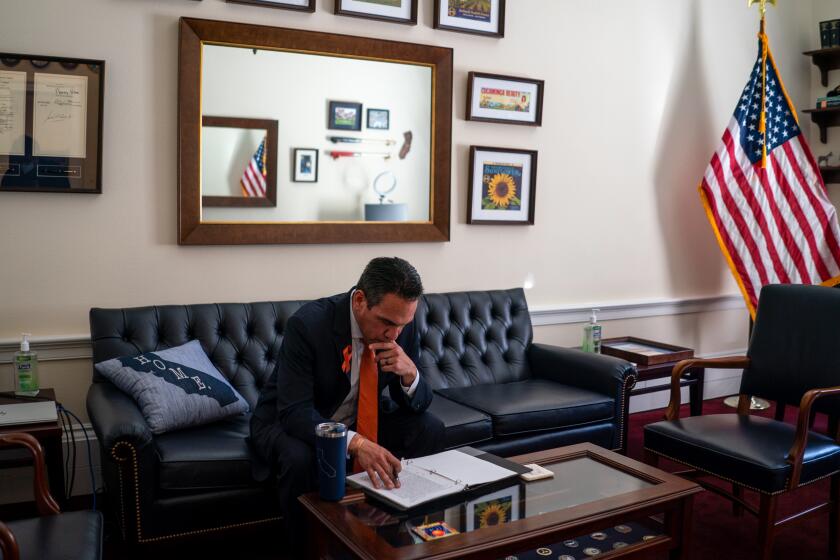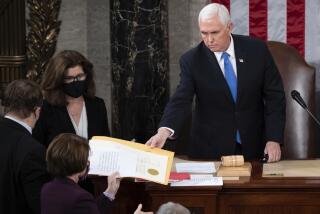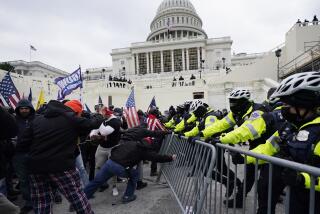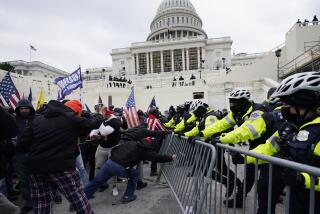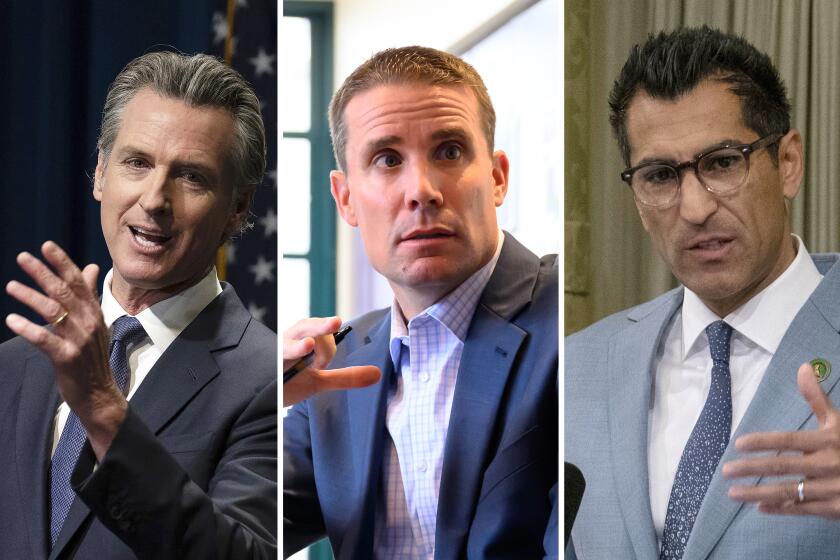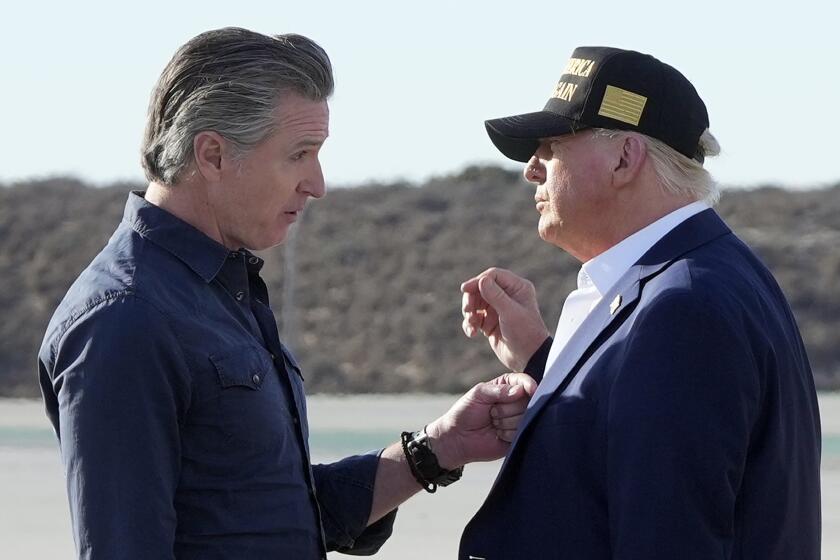Trump knew asking Pence to overturn election was illegal, Jan. 6 committee says
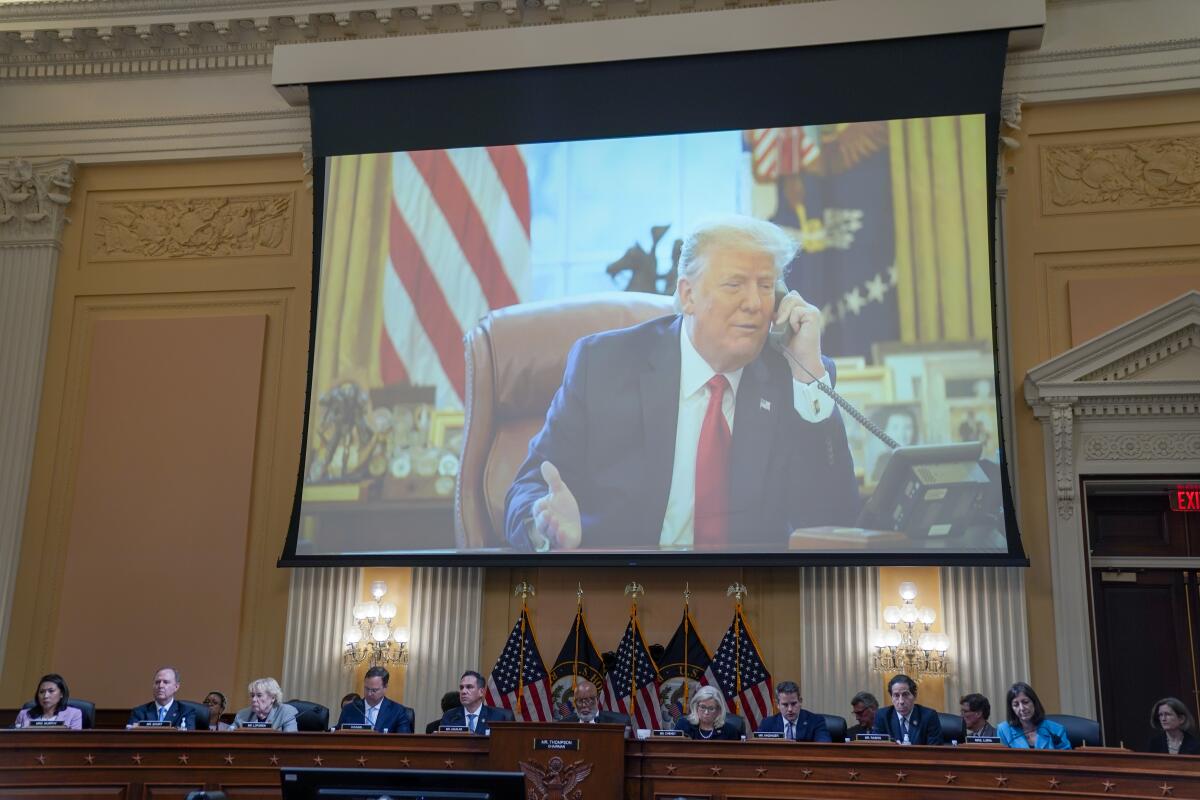
- Share via
WASHINGTON — President Trump knew that asking Vice President Mike Pence to unilaterally overturn the 2020 presidential election was illegal but pressured him to do it anyway, the House committee investigating Jan. 6, 2021, argued at its Thursday hearing, where it also made the case that Trump put Pence’s life in danger during the Capitol insurrection.
The committee outlined a multiweek effort by then-President Trump and California attorney John Eastman that included private meetings and tweets aimed at pressuring Pence to help keep Trump in office. Eastman’s theory was that Pence could either reject electoral votes outright or suspend the proceedings and declare a 10-day recess during which state legislatures would be ordered to reexamine election results.
Neither approach is allowed under the Constitution’s 12th Amendment or the Electoral Count Act of 1887, witnesses testified at the hearing.
“This is constitutional mischief,” said retired federal Judge J. Michael Luttig, who advised Pence on what authority he had as vice president on Jan. 6. “I believe that if Vice President Pence had obeyed the orders from his president and the president of the United States of America ... that declaration of Donald Trump as the next president would have plunged America into what I believe would have been tantamount to a revolution within a constitutional crisis in America.”
Luttig, who was appointed by President George H.W. Bush and was twice considered for a Supreme Court nomination, said America had narrowly missed the first constitutional crisis since the nation’s founding, which would have occurred if an elected official had acted to overturn the will of millions of voters. He warned that the country needs to act to prevent similar attempts in the 2024 election.
“Donald Trump and his allies and supporters are still a clear and present danger to American democracy,” Luttig said.
Rep. Pete Aguilar (D-Redlands) led Thursday’s hearing with committee Chair Bennie Thompson (D-Miss.) and Vice Chair Liz Cheney (R-Wyo.).
The panel also heard testimony from Greg Jacob, who as Pence’s chief counsel was at multiple meetings in which Eastman and Trump pushed the vice president to intervene. Jacob said that Pence never wavered from his initial reaction to the idea in early December.
“The vice president never budged,” Jacob said. “It just made no sense from everything that he knew and had studied about our Constitution that one person would have that kind of authority.”
The committee also highlighted video of depositions from Pence‘s former Chief of Staff Marc Short, who was also in the Eastman meetings.
The panel showed testimony from White House officials and several lawyers who said that Eastman’s theory was wrong and that they told Trump and others so many times before Jan. 6. And the committee highlighted private acknowledgements by Eastman and Trump lawyer Rudolph W. Giuliani that they knew the plan was illegal, though they continued to assert publicly it was legal.
Jacob said Eastman acknowledged in an Jan. 4 Oval Office meeting with Trump and Pence that the plan would violate the Electoral Count Act, but Eastman said he considered the statute unconstitutional and didn’t expect the courts would take up its legality.
“If the courts did not step in to resolve this, there was nobody else to resolve this,” Jacob said he told Eastman. Congress and the executive branch would be at a stalemate, and legislatures would be caught in the crosshairs, he said.
“As I expressed to [Eastman], that issue might well then have to be decided in the streets, because if we can’t work it out politically, we’ve already seen how charged up people are about this election.”
In a meeting the next day, Jacob said Eastman acknowledged that the Supreme Court would rule against them unanimously if Pence followed the plan he and Trump were proposing.
Rep. Pete Aguilar says Thursday’s Jan. 6 hearing will focus on then-President Trump and lawyer John Eastman pressuring then-Vice President Mike Pence.
Eastman, a former professor at Chapman University in Orange County, argued in memos and in meetings with state and federal lawmakers that Pence had the authority to reject states’ electoral college votes due to allegations of fraud — an act that would have left deciding the next president up to state delegations in the House — or send results back to the states to have their legislatures examine the results and decide whether they should be changed.
Luttig explained to the committee the legal reasoning he gave Pence to counter the pressure he was under from Trump and Eastman. By law, the vice president’s role when Congress certifies the electoral college results is largely ceremonial.
The latter portion of Thursday’s hearing focused on the danger Pence was in during the insurrection, starting with testimony about a loud phone call between Trump and Pence on the morning of Jan. 6, in which Pence again told Trump that he would not reject votes or delay certifying the election results. Several White House staff members said in depositions that Trump called Pence a “wimp” and a “pussy.” Pence returned to the room looking “steely, determined, grim,” Jacob noted, but did not discuss what was said.
Aguilar said the committee has drafts of Trump’s speech to supporters before the riot in which Pence is not mentioned. But Trump revised the speech to include references to Pence, and further ad-libbed as he was speaking, Aguilar said.
Aguilar pointed to evidence that White House Chief of Staff Mark Meadows was notified of the Capitol breach before 2 p.m. and informed the president right away. Trump criticized the vice president in a tweet 11 minutes after Pence was evacuated from the Senate floor as rioters approached.
“Mike Pence didn’t have the courage to do what should have been done to protect our Country and our Constitution, giving States a chance to certify a corrected set of facts, not the fraudulent or inaccurate ones which they were asked to previously certify. USA demands the truth!” Trump tweeted at 2:24 p.m.
Aguilar said the crowds inside and outside the Capitol surged when Trump posted the tweet. Soon a crowd inside the building was chanting, “Hang Mike Pence!”
The committee overlaid a map of the route along which Pence was evacuated with a second-by-second timeline of where the rioters were in the building.
“Approximately 40 feet. That’s all there was — 40 feet between the vice president and the mob,” Aguilar said. “Make no mistake about the fact that the vice president’s life was in danger.”
Aguilar also said a member of the extremist Proud Boys who is cooperating with the Justice Department had testified that if those storming the Capitol “would have found [Pence], they probably would have killed him.”
Jacob said that when Pence and his group reached the second secure location in the Capitol, the Secret Service directed them to get into cars to evacuate the complex. Pence’s staff complied, but Pence did not.
Pence didn’t want the world to see the vice president fleeing the U.S. Capitol, Jacob said, and he didn’t want to give the rioters the impression that they had succeeded.
“He was determined that we would complete the work,” Jacob said.
Aguilar also presented an email Eastman wrote to Giuliani after the insurrection that said: “I’ve decided I should be on the pardon list.”
But Eastman was not given a presidential pardon, and went on to invoke his the 5th Amendment right against self-incrimination 100 times when the committee called him to testify.
Leaving Thursday’s hearing, Thompson acknowledged that the Justice Department had written to the committee asking its members to reconsider sharing more than 1,000 depositions from its investigation. Thompson indicated that the committee would share what it had gathered, but did not provide a time line.
“We can’t stop our work because someone writes us a letter,” he said. “Now, we will cooperate with them, but the committee has its own timetable.”
Times staff writer Anumita Kaur contributed to this story.
More to Read
Get the L.A. Times Politics newsletter
Deeply reported insights into legislation, politics and policy from Sacramento, Washington and beyond. In your inbox twice per week.
You may occasionally receive promotional content from the Los Angeles Times.

